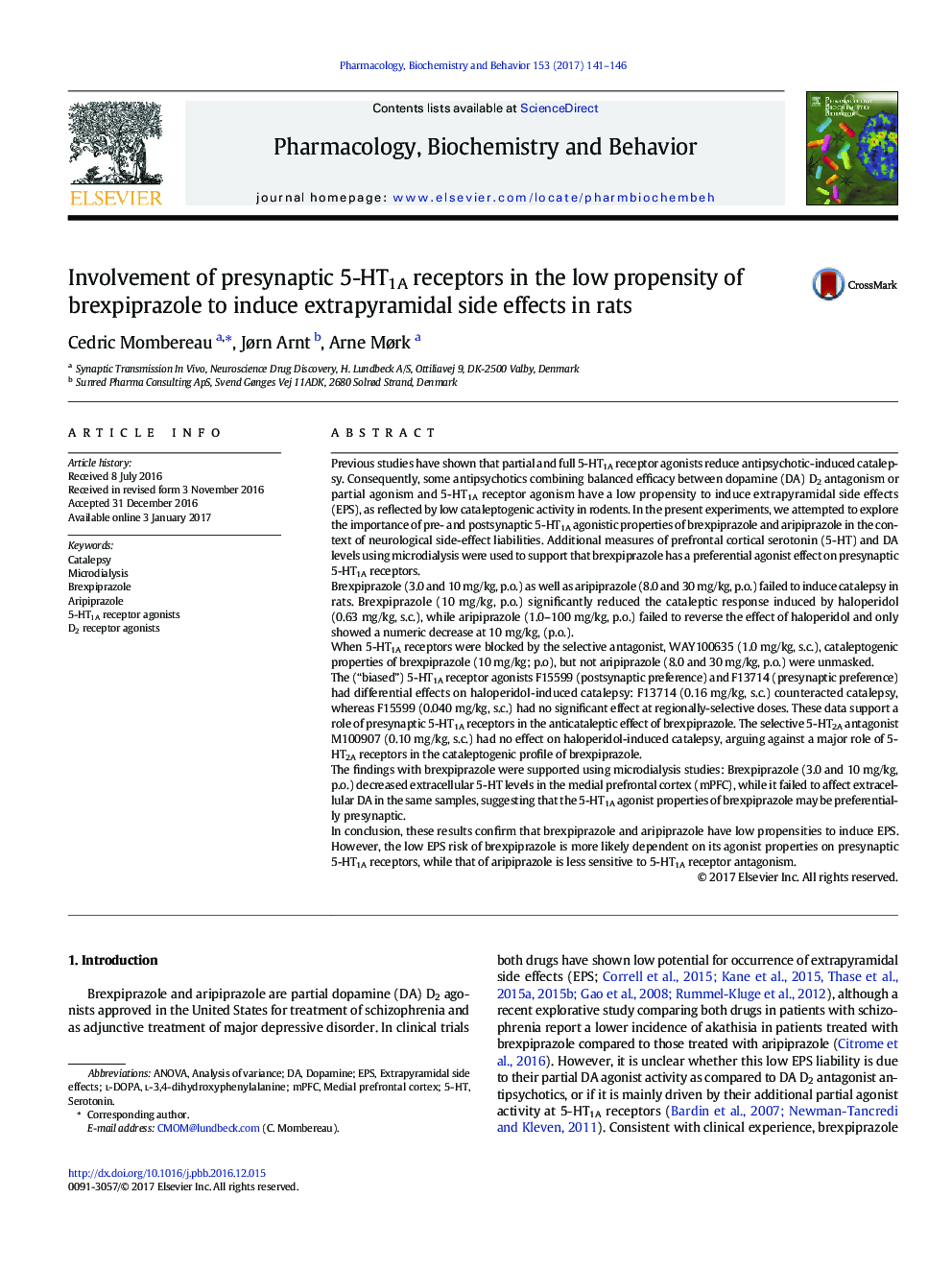| کد مقاله | کد نشریه | سال انتشار | مقاله انگلیسی | نسخه تمام متن |
|---|---|---|---|---|
| 5515226 | 1541834 | 2017 | 6 صفحه PDF | دانلود رایگان |

Highlight
- Brexpiprazole has low cataleptogenic activity due to balanced 5-HT1A/D2 activity.
- Dialysis proposes preferential brexpiprazole effect on presynaptic 5-HT1A receptors.
- Aripiprazole has low cataleptogenic activity, primarily driven by D2 agonism.
- 5-HT1A agonists reverse catalepsy by preferential effect on presynaptic receptors.
Previous studies have shown that partial and full 5-HT1A receptor agonists reduce antipsychotic-induced catalepsy. Consequently, some antipsychotics combining balanced efficacy between dopamine (DA) D2 antagonism or partial agonism and 5-HT1A receptor agonism have a low propensity to induce extrapyramidal side effects (EPS), as reflected by low cataleptogenic activity in rodents. In the present experiments, we attempted to explore the importance of pre- and postsynaptic 5-HT1A agonistic properties of brexpiprazole and aripiprazole in the context of neurological side-effect liabilities. Additional measures of prefrontal cortical serotonin (5-HT) and DA levels using microdialysis were used to support that brexpiprazole has a preferential agonist effect on presynaptic 5-HT1A receptors.Brexpiprazole (3.0 and 10Â mg/kg, p.o.) as well as aripiprazole (8.0 and 30Â mg/kg, p.o.) failed to induce catalepsy in rats. Brexpiprazole (10Â mg/kg, p.o.) significantly reduced the cataleptic response induced by haloperidol (0.63Â mg/kg, s.c.), while aripiprazole (1.0-100Â mg/kg, p.o.) failed to reverse the effect of haloperidol and only showed a numeric decrease at 10Â mg/kg, (p.o.).When 5-HT1A receptors were blocked by the selective antagonist, WAY100635 (1.0Â mg/kg, s.c.), cataleptogenic properties of brexpiprazole (10Â mg/kg; p.o), but not aripiprazole (8.0 and 30Â mg/kg, p.o.) were unmasked.The (“biased”) 5-HT1A receptor agonists F15599 (postsynaptic preference) and F13714 (presynaptic preference) had differential effects on haloperidol-induced catalepsy: F13714 (0.16Â mg/kg, s.c.) counteracted catalepsy, whereas F15599 (0.040Â mg/kg, s.c.) had no significant effect at regionally-selective doses. These data support a role of presynaptic 5-HT1A receptors in the anticataleptic effect of brexpiprazole. The selective 5-HT2A antagonist M100907 (0.10Â mg/kg, s.c.) had no effect on haloperidol-induced catalepsy, arguing against a major role of 5-HT2A receptors in the cataleptogenic profile of brexpiprazole.The findings with brexpiprazole were supported using microdialysis studies: Brexpiprazole (3.0 and 10Â mg/kg, p.o.) decreased extracellular 5-HT levels in the medial prefrontal cortex (mPFC), while it failed to affect extracellular DA in the same samples, suggesting that the 5-HT1A agonist properties of brexpiprazole may be preferentially presynaptic.In conclusion, these results confirm that brexpiprazole and aripiprazole have low propensities to induce EPS. However, the low EPS risk of brexpiprazole is more likely dependent on its agonist properties on presynaptic 5-HT1A receptors, while that of aripiprazole is less sensitive to 5-HT1A receptor antagonism.
Journal: Pharmacology Biochemistry and Behavior - Volume 153, February 2017, Pages 141-146